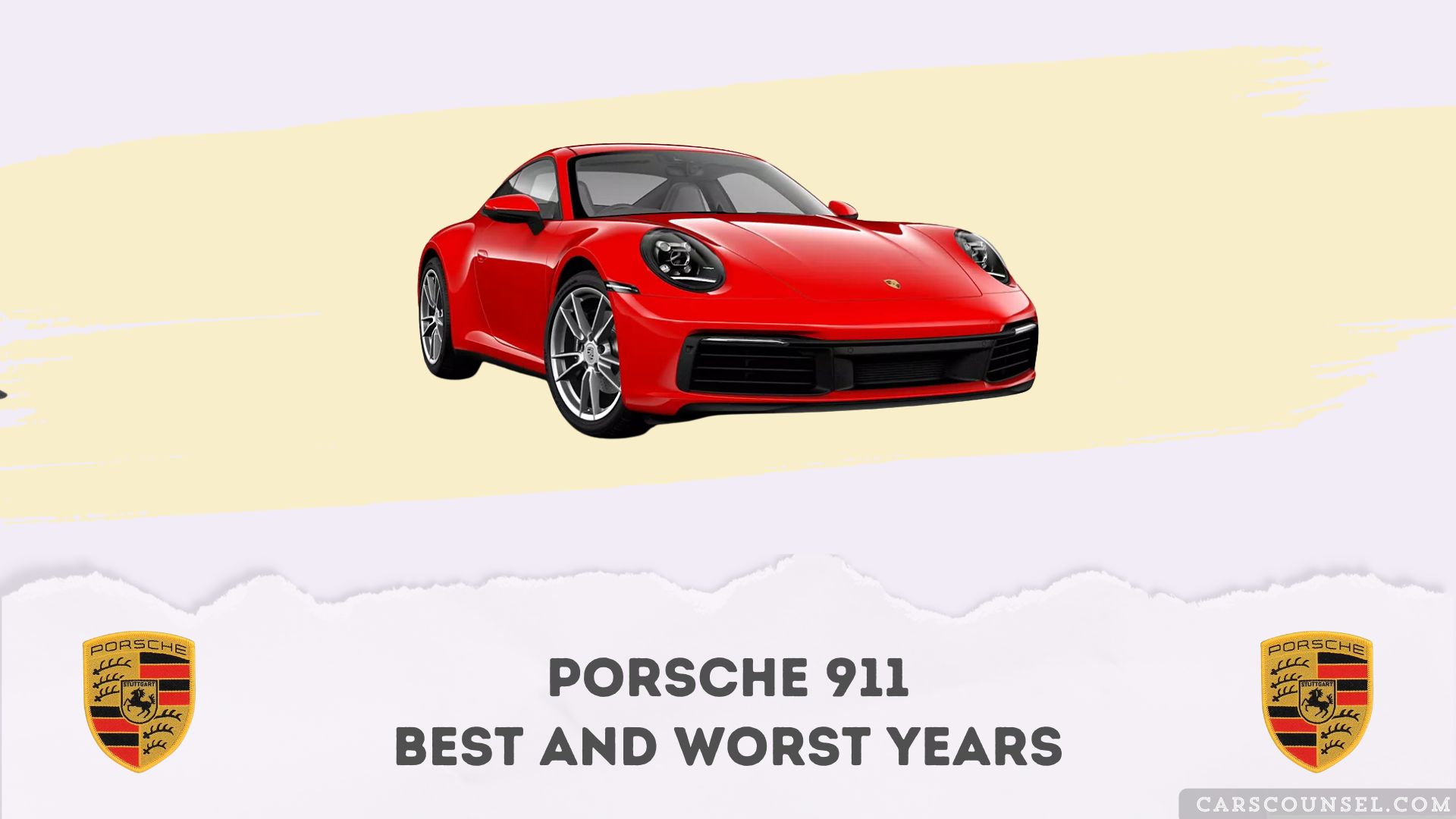As you delve into the iconic Porsche 911‘s timeline, you’ll notice a mix of triumphs and missteps. Some models, like the 1978 911SC, boast reliable aluminum engines, fuel injection, and turbocharging technology, making them highly desirable.
On the other hand, certain generations, such as the 1995 993 and 2002 996, were plagued by high prices, poor reception, and performance issues, damaging the brand’s reputation. You’re probably wondering what made these models stand out – for better or for worse – and what lessons Porsche learned along the way.

Quick Navigation
Key Takeaways
- The 1978 911SC is considered one of the best years for the 911 due to its reliable aluminum engine, fuel injection, and turbocharging technology.
- The 1995 993 generation is considered one of the worst years for the 911 due to its higher price, limited production, and failure to increase showroom traffic.
- The 2002 996 model was criticized for its water-cooled engine, which was a significant departure from traditional 911 design and technology.
- The 2009 997 generation was plagued by IMS bearing failure, leading to costly repairs and damaging the brand’s reputation.
- Common themes among the worst years include higher prices, failure to meet expectations, departure from traditional design and technology, and performance issues.
The Classic Era (1963-1972)
During the formative years of the 911, from 1963 to 1972, Porsche laid the foundation for a 60-year legacy of exceptional sports cars.
You’ll find the classic 911’s heart is a 2.0-liter H6 air-cooled flat-six engine, producing 148 horsepower and 140 pound-foot of torque. Paired with a manual transmission, it’s a recipe for driving nirvana.
The 911S, introduced in 1966, boasted 160 horsepower and 132 pound-foot of torque, accelerating to 60 mph in 7.4 seconds and reaching 141 mph.
This era set the tone for future generations, with a body shell that would last, with some alterations, until 1999.
The G-Series Evolution (1973-1989)
The G-Series Evolution, spanning from 1973 to 1989, marks a significant upgrade to the 911 lineage, introducing essential safety features and notable design changes that set it apart from its predecessors.
You’ll notice the new 911 design, which includes a raised bumper with black plastic bellows, required to meet American crash test standards.
This series also saw the introduction of the 930 Turbo, boasting a 3.3-liter intercooled engine, making it the fastest German production car.
Additionally, the G-Series improved handling with a new Porsche trailing arm Weissach rear axle design, replacing the older torsion bar suspension.
The 964 and 993 Generations (1989-1998)
As you examine the 964 and 993 generations of the Porsche 911, you’ll notice significant technology advancements that lifted the sports car’s performance.
The 964 model introduced features like automatic transmission, power steering, and ABS as standard, while the 993 generation brought a newly engineered chassis and drivetrain.
These improvements resulted in amplified performance, with the base model 911 producing 270 horsepower and the 911 Carrera 2S coupe accelerating to 60 mph in 5.4 seconds.
Technology Advancements
How dramatically did the 964 and 993 generations transform the 911’s technological landscape?
You’ll find significant advancements under the hood, where fuel injection replaced carburetors, and in the transmission, with the introduction of a four-speed automatic transmission, known as Tiptronic.
This marked a significant shift away from manual transmissions.
Additionally, the 964 model came standard with power steering, ABS, and a dual-mass flywheel.
These innovations not only improved performance but also refined overall driving experience.
The 993 generation continued this trend, boasting an all-aluminum subframe and multilink rear suspension, further solidifying the 911’s reputation as a technological powerhouse.
Improved Performance Features
You’ll notice significant leaps in performance with the 964 and 993 generations, thanks to a slew of innovative features.
The 964’s all-wheel-drive Carrera 4 model, for instance, can reach 60 mph in just 5.1 seconds and a top speed of 157 mph.
The 993 generation takes it up a notch with its multilink rear suspension, all-aluminum subframe, and engine modifications.
You’ll feel the difference with the base model’s 270 horsepower, the Carrera 2S coupe‘s 285 horsepower, or the Turbo’s 400 horsepower, which propels you to 60 mph in 3.8 seconds and a top speed of 180 mph.
The 996 Generation: A New Era (1998-2004)
You’ll find that the 996 generation, which spanned from 1998 to 2004, brought significant changes to the iconic 911.
However, it’s also plagued by issues like IMS bearing failure, water-cooled engine problems, and the notorious “fried egg” headlights that sparked criticism.
As you delve into this generation, you’ll need to weigh these drawbacks against its impressive performance and innovative technologies.
IMS Bearing Failure
The 996 generation of Porsche 911, produced from 1998 to 2004, was marred by a significant engineering flaw: IMS bearing failure.
You may be affected if you own an early model year, as IMS failure was more prevalent in these cars. The IMS bearing failure occurs when the bearing fails, causing the intermediate shaft to seize, resulting in catastrophic engine damage.
Later model years saw design improvements, reducing the risk of IMS failure. Due to the widespread issue, Porsche faced a class-action lawsuit and eventually redesigned the IMS bearing in later models, making it more reliable and durable.
Water-Cooled Engine Issues
When Porsche introduced the 996 generation in 1998, it marked a significant departure from the iconic air-cooled engines that had defined the 911 for decades.
You’ll find that the water-cooled engine, while promising, had its own set of issues. The IMS bearing failure, a common problem, could lead to costly repairs and even engine replacement.
Additionally, the engine had a tendency to overheat, causing damage to the engine and other components. The water-cooling system was prone to leaks, further exacerbating the reliability issues that plagued the 996 generation.
Egg-Shaped Headlights Criticism
Porsche’s decision to stray from traditional design cues with the 996 generation‘s egg-shaped headlights sparked widespread criticism.
You may have found the unusual design jarring, especially since round headlights had been a hallmark of the Porsche 911’s aesthetic for decades.
The radical departure from tradition led many fans and critics to feel that the egg-shaped headlights detracted from the car’s appeal.
Despite this, the 996 generation still produced exceptional high-performance vehicles, including the Turbo model.
However, the design controversy was eventually addressed in the subsequent 997 generation, which returned to a more traditional round headlight design.
The 997 Generation: A Return to Form (2005-2011)
You stepped into the 2005 Porsche 911 and felt a return to form, as if the iconic sports car had rediscovered its mojo.
The 997 generation offered a range of trims, including the Turbo, which boasted 415 horsepower and 415 pound-foot of torque.
You accelerated to 60 mph in 3.9 seconds and reached 194 mph, making it one of the fastest production 911s of its time.
The rear suspension, paired with the PASM system, provided exceptional handling and ride quality.
With transmission options like the seven-speed PDK and a six-speed manual, you were spoiled for choice.
The 991 and 992 Generations: Modern Marvels (2011-present)
Building on the 997 generation’s rediscovery of its mojo, the 991 and 992 generations of the Porsche 911 take performance and technology to new heights.
As a sports car enthusiast, you’ll appreciate the exceptional power and road handling of these modern marvels.
The 991’s twin-turbocharged engine produces 370 horsepower, while the 992 generation offers multiple powertrains, including naturally aspirated and turbocharged options, generating up to 641 horsepower.
Special edition models, like the Speedster, offer exceptional performance in a unique 911 R body style.
With acceleration to 60 mph in just 3.4 seconds, these generations solidify the 911’s status as a high-performance icon.
The Best Model Years (1965, 1969, 1973, 1975, 1978, 1987)
Throughout the 911’s storied history, certain model years stand out for their exceptional performance, innovative design, and lasting impact on the iconic sports car. You’ll find that the best Porsche 911 years share a common thread of groundbreaking engineering and style.
| Year | Model | Notable Features |
|---|---|---|
| 1965 | 901 | Classic formula of flat-six engine and body shell |
| 1969 | 911S | Fuchs forged alloy wheels, lengthened wheelbase |
| 1973 | Carrera RS | 2.7-liter engine, 210 horsepower, “ducktail” spoiler |
From the 1975 Turbo Carrera’s dramatic use of turbocharging technology to the 1978 911SC’s reliable aluminum engine and fuel injection, these models have solidified their places as the best years for the 911.
The Most Criticized Model Years (1995, 2002, 2009)
While the 911’s storied history is marked by numerous triumphs, certain model years have faced criticism from enthusiasts and owners alike.
You might be surprised to learn that the 1995 993 generation, with its limited production of the RS America model, was criticized for its higher price and failure to increase showroom traffic.
In like manner, the 2002 996 model received criticism for its water-cooled engine, which didn’t sit well with brand loyalists who preferred older air-cooled models.
The 2009 997 generation, plagued by IMS bearing failure, led to costly repairs and damaged the brand’s reputation.
When looking at performance cars, make sure to check out our guides on models like the Porsche Panamera, Porsche 996, Porsche 997 and Porsche Boxster. Knowing which model years to target and which to avoid is crucial. Our expert reviews break down these models, providing insights into the years that are celebrated for their engineering excellence and driving satisfaction, as well as those that are best to avoid due to potential issues.

